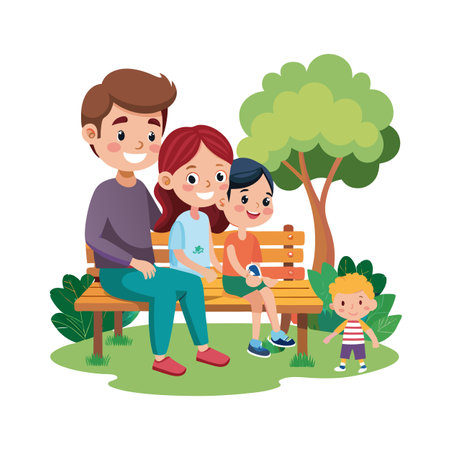Understanding the Importance of Shared Spaces
In today’s fast-paced American lifestyle, shared spaces within the home and community have become more than just physical locations—they are vital environments that nurture family bonding and social wellbeing. The design and use of these spaces play a pivotal role in fostering meaningful connections among family members and friends. Research consistently highlights that intentional, well-organized communal areas encourage interaction, communication, and emotional support. When families spend time together in shared environments—whether it’s around the kitchen table, in a cozy living room, or at a neighborhood park—their mental health and sense of belonging are strengthened. Studies from leading universities indicate that physical proximity, when paired with mindful use of space, can reduce feelings of isolation and build resilience against stress. By understanding the profound impact of shared environments, families can make conscious choices to prioritize connection over convenience, creating daily opportunities for togetherness that promote both individual and collective wellbeing.
Design Principles for Family-Centered Spaces
When it comes to creating shared spaces that truly foster connection, the design must go beyond aesthetics—prioritizing functionality, inclusivity, and opportunities for meaningful interaction. Whether you’re updating a living room, kitchen, or backyard patio, thoughtful planning can transform everyday environments into vibrant hubs for family bonding and social wellbeing.
Practical Strategies for Inclusive, Multi-Functional Spaces
Successful family-centered spaces are built on flexibility and accessibility. Here are some actionable strategies:
- Open Layouts: Removing barriers between areas like the kitchen and living room encourages natural conversation and allows everyone to be part of activities—whether cooking, homework, or playtime.
- Multi-Purpose Furniture: Invest in pieces that serve more than one function—think storage ottomans, extendable dining tables, or modular sofas that can adapt to gatherings of any size.
- Activity Zones: Designate specific corners or zones for reading, games, crafts, or exercise to appeal to all age groups and interests while keeping everyone together in a shared environment.
- Tech-Free Nooks: Incorporate areas where screens are minimized so families can focus on face-to-face communication and quality time.
- Accessible Design: Ensure spaces are navigable for every family member—including young children and those with mobility needs—by minimizing clutter and using non-slip surfaces.
Key Elements of Family-Focused Shared Spaces
| Element | Description | Benefits |
|---|---|---|
| Flexible Seating | Sofas, benches, floor cushions that can be rearranged easily | Supports group activities and spontaneous gatherings |
| Central Gathering Point | A large table or fireplace as a focal point | Encourages group meals and conversations |
| Naturally Lit Areas | Maximized windows or skylights | Lifts mood and increases time spent together indoors |
| Cultural Touches | Display family photos, art, or heirlooms | Cultivates a sense of belonging and shared identity |
| Open Storage Solutions | Shelves or baskets for easy access to games/books | Makes shared activities more inviting and accessible |
Nurturing Interaction Through Thoughtful Design Choices
The ultimate goal is to create an environment where connection happens naturally. By considering how space is used daily—and by whom—you’ll foster an atmosphere that welcomes laughter, conversation, and collaboration. Remember: small changes like moving furniture to face each other or setting aside a basket for board games can have a big impact on how families connect at home.

3. Incorporating Nature and Nutrition-Inspired Elements
Designing shared spaces that blend natural features with nutrition-focused intent can significantly elevate the quality of family connections and overall wellbeing. In American homes, where busy schedules often limit time together, creating environments that encourage gathering around food and nature is a powerful tool for fostering lasting bonds.
The Power of Natural Elements in Shared Spaces
Integrating elements such as indoor plants, natural light, or even small herb gardens into communal areas does more than just beautify a room—it can also reduce stress and improve mood. Research shows that exposure to greenery and sunlight supports mental health, encourages relaxation, and creates a welcoming atmosphere where conversation flows naturally. Families are more likely to linger in spaces that feel vibrant and alive, making it easier to connect over everyday moments.
Designated Dining Areas: Nourishing Body and Relationships
Beyond aesthetics, the layout of shared eating spaces matters. Carving out intentional zones for family meals—whether its a cozy breakfast nook or an inviting dining table—signals the importance of coming together to share food. American culture values the ritual of gathering for dinner, and nutrition-inspired design can help reinforce this tradition. Features like open kitchens, comfortable seating, and easy access to healthy foods invite everyone to participate in meal preparation and dining, making shared meals both enjoyable and accessible.
Nutrition-Focused Design for Holistic Health
When families are surrounded by cues that support balanced eating—like visible fruit bowls or dedicated spots for nutritious snacks—they’re more likely to make healthy choices. Thoughtful design can subtly encourage mindful eating habits without feeling restrictive. By placing emphasis on fresh foods and communal experiences, these environments nurture not only physical health but also emotional wellbeing, reinforcing the idea that nourishment goes beyond what’s on the plate.
Incorporating nature and nutrition-inspired elements into shared spaces isn’t just a trend; it’s a meaningful approach rooted in science and tradition. By thoughtfully designing environments that bring people together around natural beauty and wholesome meals, we create a foundation for stronger family bonds and greater social wellbeing.
4. Fostering Flexibility and Personal Expression
In modern American households, the ability for shared spaces to adapt and reflect each family member’s unique personality is more important than ever. As families grow and lifestyles change, a rigid environment can hinder both connection and personal development. Instead, flexible design empowers families to create an environment that supports communal activities while still honoring individual preferences.
The Value of Adaptable Spaces
Adaptable spaces go beyond simply rearranging furniture. They are designed with multipurpose use in mind, allowing a living room to transform from a movie night hub to a quiet reading nook or a play area for kids. This flexibility encourages all family members to participate in shaping their environment, which enhances feelings of belonging and ownership.
Accommodating Evolving Needs
Family needs shift over time—children grow, hobbies develop, and work-from-home requirements emerge. Incorporating modular furniture, movable partitions, or convertible tables allows the space to evolve alongside these changes. Consider the following examples:
| Feature | Communal Use | Individual Use |
|---|---|---|
| Sofa Sectionals | Group seating for movies/games | Personal lounge area for reading |
| Foldable Desks | Homework station for siblings | Private workspace for remote work |
| Open Shelving | Display family photos or books | Showcase individual collections/artwork |
Encouraging Personal Expression
An inviting shared space celebrates each family member’s interests and cultural heritage. Letting children choose wall art or involving teens in selecting paint colors fosters creativity and self-esteem. Rotating seasonal décor or establishing zones for hobbies (like crafting corners or music nooks) honors both togetherness and individuality.
Nourishing Social Wellbeing Through Design Choices
A well-designed flexible space not only meets practical needs but also strengthens emotional bonds. When everyone feels seen and heard through their environment, it cultivates respect, empathy, and open communication—key ingredients for long-term social wellbeing within the family unit.
5. Encouraging Routine Family Activities
One of the most effective ways to strengthen family bonds and foster social wellbeing is by establishing regular traditions within shared spaces. Well-designed communal areas, such as open kitchens, comfortable dining nooks, or cozy living rooms, set the stage for families to create meaningful routines that become cherished parts of daily or weekly life.
The Power of Tradition in Shared Spaces
When a home is intentionally crafted with connection in mind, it naturally encourages activities that bring everyone together. For example, a spacious kitchen island can invite family members to cook side by side, transforming meal preparation into a collaborative experience instead of a solo chore. Similarly, an inviting game table in the living room can be the centerpiece for weekly board game nights, sparking laughter and conversation long after the games are put away.
Reinforcing Connection Through Routine
Regularly scheduled family activities do more than fill up a calendar—they help build trust, communication skills, and emotional security. Whether it’s Sunday pancake breakfasts or Friday night movie marathons, these rituals offer consistency and something for every family member to look forward to. Over time, these moments become woven into the fabric of family identity, offering comfort and stability even during busy or stressful periods.
Design Tips for Encouraging Traditions
To make routine activities easy and appealing, design your shared spaces with flexibility and comfort in mind. Incorporate versatile seating arrangements that accommodate both intimate conversations and larger gatherings. Choose durable surfaces for craft or cooking projects, and ensure there’s plenty of accessible storage for games or hobby supplies. Thoughtful lighting and personalized décor can also make these spaces feel warm and welcoming—perfect for nurturing family traditions.
By prioritizing the creation of inviting communal areas that support everyday rituals, families can turn their homes into true hubs of connection and wellbeing. These traditions not only bring joy in the moment but also lay the foundation for lasting relationships and happy memories.
6. Impact on Broader Community and Social Wellbeing
Thoughtfully designed shared spaces within the home do more than strengthen individual family bonds—they set the stage for positive ripple effects throughout American neighborhoods. When families prioritize connection through inviting kitchens, open living rooms, or multi-use outdoor patios, these environments naturally become hubs for interaction that extend beyond the household. For example, a welcoming front porch can inspire spontaneous conversations with neighbors, while backyard gatherings encourage communal meals, potlucks, or block parties that celebrate local diversity and unity.
Fostering Neighborhood Ties Through Design
Home environments that embrace openness and accessibility often invite collaboration and mutual support among neighbors. In many U.S. communities, families who invest in shared play areas, vegetable gardens, or communal fire pits find themselves at the heart of neighborhood networks. These intentional spaces act as magnets for meaningful connections—children form friendships over shared activities, parents swap healthy recipes or gardening tips, and everyone benefits from a greater sense of belonging and security.
Promoting Collective Wellness
The influence of well-designed shared spaces extends to social wellbeing on a broader scale. As families model inclusive behaviors and host community events—like weekend cookouts focused on nutritious foods or wellness workshops in their living rooms—they promote healthy habits across the neighborhood. These gatherings foster emotional support systems and encourage positive lifestyle changes, such as group exercise routines or local food swaps, which enhance both physical health and emotional resilience.
Building Resilient Communities
Ultimately, homes that are designed to nurture connection serve as catalysts for resilient communities. By bridging the gap between private family life and public social engagement, these environments help foster trust, empathy, and cooperation—key ingredients for thriving American neighborhoods. As each household invests in creating welcoming shared spaces, they contribute to a larger culture of care where everyone feels seen, supported, and empowered to live well together.

